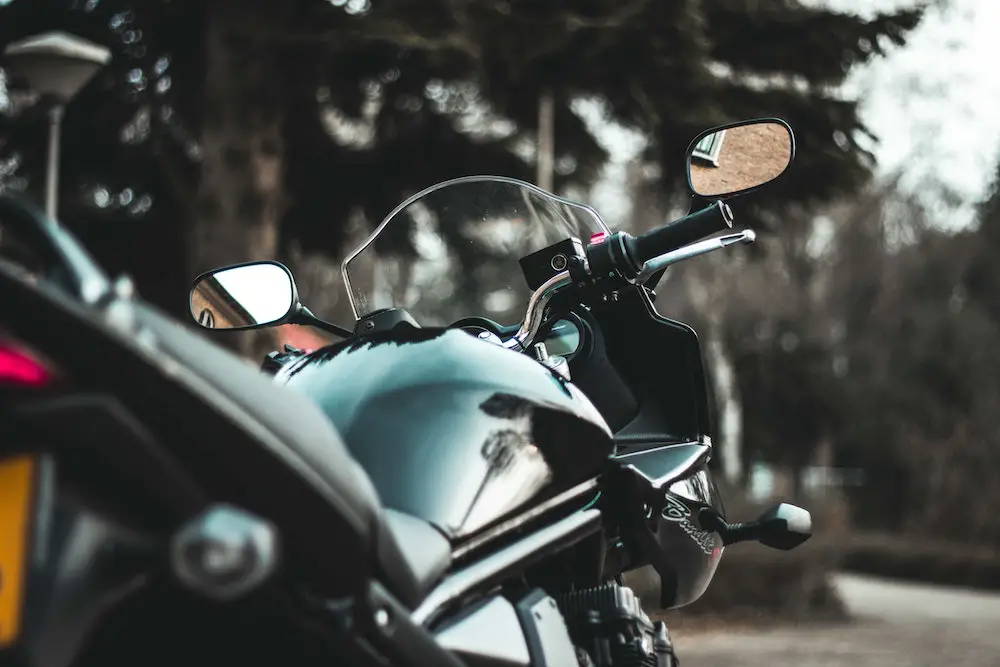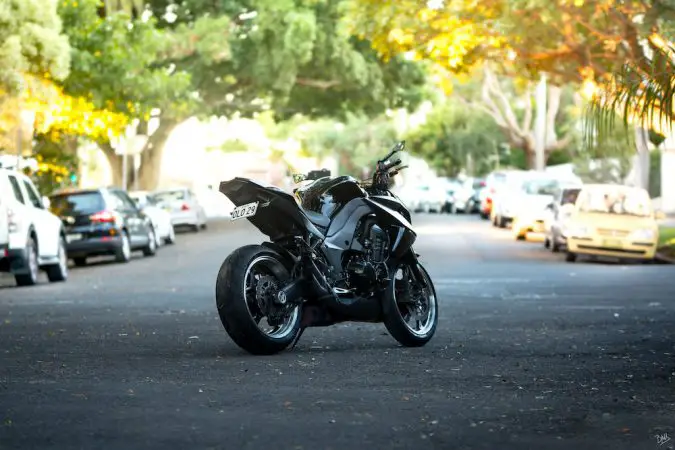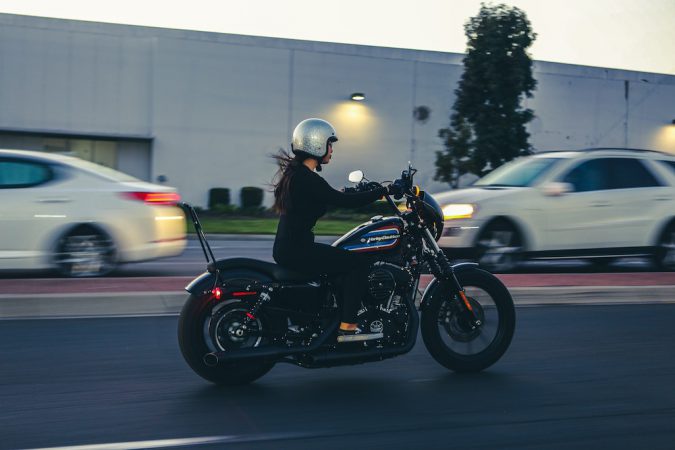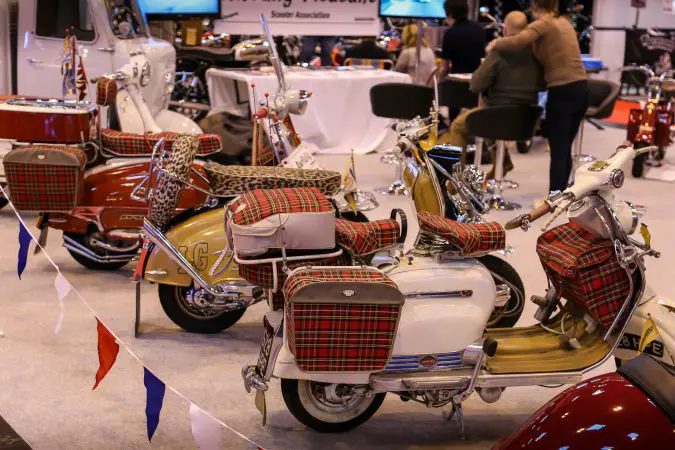We mostly talk about cars here at MotorVerso, but for a change let’s talk about motorized two-wheeled vehicles. In this post, we’ll tackle the differences between types of motorized bikes. So, moped vs motorcycle: what are the differences?
Don’t worry, we’ll answer all questions you might have regarding moped vs motorcycles. From the differences and which one might be right for you. While we’re at it, we’ll also take a look at what makes a scooter. Here’s all you need to know about motorized two-wheel vehicles:
Moped VS Motorcycle: The Legal Definition
Before we get into the differences, let’s take a look at the legal definition. This will give you a general idea of how they’re different. However, note that the definition in each state may vary, but they’re generally minor differences. Let’s take a look at the legal definition of a moped first:
What Classifies As A Moped?
According to USLegal, a moped is defined as “a vehicle that has two or three wheels, no external shifting device, and a motor that does not exceed 50 cubic centimeters piston displacement and cannot propel the vehicle at a speed greater than 30 miles per hour.”
Additionally, mopeds may also have pedals, if it’s not entirely propelled by their motor. The motor/engine is there to assist the rider while pedaling. This makes riding a moped more convenient than riding a normal bike.
As mentioned, the definition may vary depending on the state. While most states require mopeds to have an engine smaller than 50cc, Kansas allows mopeds to have an engine as big as 130cc. Moreover, some states may require you to have a motorcycle license to operate a moped, in addition to insurance (for more insight, check out our guide on how much is motorcycle insurance and how to choose the right motorcycle for you) and protective gear. While in other states, it’s more of a free for all.
What Classifies As A Motorcycle?
Meanwhile, a motorcycle is a motor vehicle having a saddle for use of the rider and designed to travel on not more than three wheels in contact with the ground according to Law Insider. Again, the definition often varies depending on the state. The key thing here is that a motorcycle doesn’t have the same restrictions as a moped.
Additionally, the law sees a motorcycle as a motorized vehicle that has no more than three wheels that can travel at speeds greater than 30mph. Anything with four wheels, no matter how small it is such as the Renault Twizy, has to be classified as a car.
How About Scooters?
So, how about scooters then? There are two ways you can define a scooter; the first is those electric scooters that have handlebars, an electric motor, and a floorboard where you stand as you ride. You know, like those kick scooters we used to have as a kid but with an electric motor.
However, we’re talking about motorized scooters. They usually fall under the motorcycle category, since they have engines larger than 50cc and require an M2 motorcycle permit to operate (in most states). So, a scooter is essentially a motorcycle. The key difference is the chassis and design, which we’ll discuss more in the differences segment.
If you weren’t confused already, note that the terms scooter and moped are often interchangeable. Don’t be surprised when you find a dealer website that refers to a 150cc scooter as a moped.
Moped VS Motorcycle Legal Definition: The Bottom Line
Okay, this may have gotten a bit confusing, as it often is with legal definitions. Let us try to simplify this, here’s the bottom line: a moped is any motorized two or three-wheeled vehicle that has speed and motor size restrictions. Meanwhile, a motorcycle doesn’t have these restrictions, and anything that has two or three wheels can be considered a motorcycle.
To make things easier, we’ll stick to the legal definitions. So, we’ll refer to anything with a 50cc engine or less as a moped. Meanwhile, anything larger than that is either a scooter or a motorcycle, depending on the chassis.
The key takeaway here is that it’s important to check your state laws before making a purchase. As mentioned, some states may require you to have a motorcycle license, insurance, and wear protective gear when operating a moped. You’ll want to check the requirements in your state to make sure you comply when you operate any one of these motorized bikes.
There’s a helpful list from Genuine Scooters that may be a helpful guide for you to further learn about motorized bikes regarding the laws that vary by state. You can read it here.
Still with us? Great, now let’s take a look at the differences, it’ll probably help you to understand it better:
Moped VS Motorcycle: Key Differences
To make it easier, let’s take a look at the differences in characteristics between these motorbikes. Let’s start with the moped:
1. Moped Specifications
- Engine Size: <50cc or electric motor making less than 1.5 horsepower. Some states may allow more.
- Wheel Size: Varies by the manufacturer.
- Speed: <30mph, although some states may allow it to go as fast as 35mph.
- Legal Age: 15 – 16 years old.
- Motorcycle License Requirement: Varies by state.
- Highway Usage: Illegal.
2. Motorcycle Specifications
- Engine Size: 250cc or larger (or an electric motor).
- Wheel Size: 16 inches or larger.
- Speed: Varies by engine size and power.
- Legal Age: 16 years old.
- Motorcycle License Requirement: Yes
- Highway Usage: Legal.
3. Scooter Specifications
- Engine Size: 50cc to 250cc (or an electric motor).
- Wheel Size: 10 – 16 inches depending on make and model.
- Speed: Varies by engine size and power.
- Legal Age: 14 – 16, varies by state.
- Motorcycle License Requirement: Yes.
- Highway Usage: Legal.
At the risk of sounding like a broken record, the key difference between them is the engine and speed restrictions. Mopeds are typically limited to 50cc and have a top speed of no more than 30mph. While a scooter usually has an engine size of around 50cc – 250cc, with no speed restrictions.
Meanwhile, motorcycles mostly have an engine larger than 250cc with no speed restrictions. The key difference with a scooter is in the chassis: as mentioned, a scooter has a step-through chassis with a floorboard where you place your feet and you can stand on it. This type of chassis means the engine or motor sits on the rear suspension.
Meanwhile, motorcycles have the engine mounted in the middle of the frame with the gas tank above it. This type of chassis means you’ll have to swing a leg over the chassis to get on it. Also, your feet will rest on footsteps at the side of the frame rather than a floorboard as you ride.
Moped VS Motorcycle: Which One Is Right For You?
So, with these differences in mind, which type of motorized bike is right for you? Here are a few things to keep in mind when deciding which one might be right for you:
Moped VS Motorcycle: What Are You Going To Use It For?
The first question is what are you expecting the bike to do? If you’re looking for a compact urban commuter, you should consider mopeds. They’re cheap to buy and to run, maneuverable, plenty fast enough for urban commutes such as going to the office or grocery shopping.
However, the speed, motor, and highway restrictions mean they’re going to be confined in the city. If you’re looking to use them for longer commutes, consider a scooter or a motorcycle instead. You can ride either of them on the highway, which means you can use them both for urban commutes and traveling.
If you’re still going to use them mostly in the city but might need more flexibility, then a scooter is the ride for you. Their compact size means they’re still going to be maneuverable around tight city spaces. Additionally, they’re usually more fuel-efficient than motorcycles.
However, if you know you’re going to use them for long trips, you’ll want to consider getting a motorcycle. Their larger size makes maneuvering in tight spaces a bit more difficult. But they’re going to be more flexible and comfortable for long trips, especially if you get a touring bike.
Moped VS Motorcycle: What’s Your Budget?
As with any purchase, you’ll also need to consider your budget. A moped costs around $2,000 – $3,000, but some mopeds may be under that. Meanwhile, scooters are typically somewhere between $2,500 – $7,000. However, luxury and high-performance scooters – yes, they exist – may cost up to $10,000 if not more.
If you’re on a tight budget, a scooter is probably your best bet. They offer the flexibility of motorcycles, but most of the time they’re cheaper. However, keep in mind that scooters will require you to register and title them, which costs money. While mopeds often don’t require you to register them depending on the state.
If you’re not on a tight budget, consider motorcycles altogether. They’re more flexible, faster, and look cooler. They start at around $3,500 brand new, such as the Kawasaki Z125. But if you want something with a larger engine, such as around 300cc – 500cc, you’re going to have to shell out somewhere between $4,500 – $7,000.
Of course, if you’re looking to splurge, plenty of powerful bikes out there that will cost you tens of thousands, if not hundreds of thousands of dollars. However, before you splurge, consider your riding skill…
Moped VS Motorcycle: How’s Your Riding Skill?
If you’re a novice, you’ll want either a moped, a scooter, or a small motorcycle. Riding a moped or a scooter is – for the most part – pretty straightforward. You get on it, pull the kickstand in, turn it on, and twist the throttle to get going. Then use the right lever for the front brakes, and the left lever to use the rear brakes.
Mopeds and most scooters use a continuously variable transmission (CVT), which is an automatic transmission that doesn’t require manual shifting and this makes riding them easier. If you know how to ride a bike, with a bit of practice you’ll ace your motorcycle license test (which is required for a scooter) in no time.
On the other hand, most motorcycles have a manual transmission. This means you’ll have to manually shift them; clutch in with the left lever, then shift up or down by using a shifter near your left foot. While it’s pretty easy once you get going, judging where the clutch will bite when you set off may be difficult.
In a car, let the clutch out too early and the engine cuts off. Put in too much power, then you’ll have a jerky start and maybe slightly spin the driven wheels. The same goes when you’re on a bike, but spinning the wheels may mean catastrophe.
You may fall over if you’re not careful. At best, this results in a scuffed chassis and fairing. But at worst, you’ll have a bruised knee, maybe even a couple of broken bones.
It’ll be even more difficult in a powerful bike. If you’re not confident in your riding skills, we recommend sticking to a scooter as you try to improve. Or start with a small motorcycle, such as the Kawasaki Z125 we mentioned earlier.
Which One’s For You?
The bottom line is this: if you have limited riding skills, stick to a scooter or a moped. If you’re an experienced rider, and you know you’re going to use your motorcycle outside of the city, you’ll want a motorcycle. Otherwise, stick to a scooter, and our beginner’s guide to motorcycles might help you prep for that biker life.
Motorcycles are more powerful, making it easier to keep up with highway speeds, and depending on the type, they can be more comfortable than a scooter. With that settled, which one should you buy? Well, that neatly brings us to our next section…
Moped VS Motorcycle: Types And Recommendations
The next question is, exactly what make and model should you buy? Here are our recommendations for mopeds:
- Genuine Scooter Company Rattler 50 ($2,399).
- Vespa Primavera 50 ($3,999).
- SYM Mio 50 ($1,999).
For more options, we recommend taking a look at this list. If you’re looking for a scooter, here are our recommendations:
- Honda PCX 150 ($3,699).
- Vespa Sprint 150 S ($5,749).
- Vespa Elettrica ($7,499).
- Piaggio Beverly 350 Tourer ($6,599).
Note that The Honda PCX is a maxi-scooter, meaning it’s bigger than standard scooters. If you’re looking for something smaller, we recommend taking a look at the Vespa Sprint lineup.
Now, motorcycles are a bit more complicated. There are many types of motorcycles, including sportbikes, touring bikes, cruisers, naked bikes (they’re like sportbikes but the handlebar sits higher and has no fairing), and mini naked bikes among others.
So, our recommendation will vary depending on your needs and desired motorcycle types. Here are our recommendations depending on the type:
1. Mini Nakeds Or Standard
As mentioned, you’ll want something small and low-powered if you’re a beginner. In this case, you’ll want to look at mini naked bikes or sometimes referred to as “standard” bikes. Their engines are usually around 125cc to 250cc large, but 300cc models are available if you want more power. Examples of this include:
- Kawasaki Z125 Pro SE ($3,399).
- Honda CB300R ($4,949).
- KTM 200 Duke ($3,999).
For more recommendations, you can take a look at a list of small motorcycles for beginners here.
2. Sportbikes
If you’re a keen rider and have the skills, sportbikes may be for you. There’s a virtually endless option for sportbikes, and their engine size varies from 250cc to 1,000cc or more. Consider the Honda CBR lineup, the Kawasaki Ninja lineup, and the Suzuki GSX lineup.
If you’re a beginner, consider the smaller engine ones such as the Honda CBR250RR. But if you’re confident in your riding skills, consider the bigger engine versions such as the CBR600RR and Kawasaki ZX-6.
If you don’t want Japanese bikes, take a look at BMW’s lineup, Ducati, and MV Agusta. Keep in mind that these European manufacturers rarely offer anything with an engine smaller than 600cc.
We especially recommend the Kawasaki H2 if you’re looking for something unique since it has a supercharged engine. That supercharger whistle as you rev the bike is addicting to hear.
There are plenty of options out there, and a list of recommendations for sportbikes deserves its own article. We recommend figuring out the engine size that you want to get and then taking a look at what the manufacturers we mentioned above have to offer.
3. Naked Bikes
Naked bikes are usually sportbikes but with a higher handlebar and no fairing, hence why they’re called naked. This allows the rider to have a higher sitting position, making them more comfortable and more ideal for long journeys.
They’re similar to the mini naked bikes we mentioned earlier, but with a larger chassis and engine. And just like sportbikes, they come in a variety of engine sizes from 400cc to 1,000+cc. Here are some naked bikes you should consider:
- Triumph Speed Triple RS ($18,300).
- Kawasaki Z400 ABS ($4,999).
- MV Agusta Dragster 800RR ($23,440).
However, if you’re going to use your motorcycles for long journeys, touring and sport touring bikes might be for you.
4. Touring And Sport Touring
Keep in mind that touring bikes are significantly larger and heavier than other motorcycles, making them quite hard to handle if you’re a new rider.
They’re enormous because touring bikes are meant to have amenities for cross-country touring. Such as a large amount of storage, large fairings to block the wind and weather as you ride, safety features, and a big engine to haul extra loads and keep up with highway speeds. And of course, the large size comes with a large price:
- Honda Gold Wing Tour ($23,900).
- Harley-Davidson Road Glide Special ($26,699).
- BMW K1600GT ($23,895).
Sport touring bikes on the other hand is a mix of sport and touring bikes as the name suggests. They’re smaller than touring bikes, but often still have a high sitting position to make riding more comfortable, similar to naked bikes. Here are some sport-touring bikes you should take a look at:
- Triumph Tiger 800 XCX ($14,600).
- BMW S1000 XR ($17,495).
- Yamaha XT1200Z Super Tenere ($16,299).
You can’t go wrong with a touring or sport touring motorcycle when it comes to long journeys. Speaking of which, Georgia has excellent roads for you to explore with your bike.
Anyway, if you want something more stylish, the next class of motorcycle might be for you:
5. Cruisers Or Choppers
Cruisers and choppers are those low-riding motorcycles where you sit low down, slightly lean back, and are meant for cruising either around town or cross-country. The term is often interchangeable, but people will often refer to choppers as those motorcycles with really high handlebars.
The most obvious examples are Harley Davidson bikes, that’s how they made their name. Here are some of the best cruisers you may want to consider:
- Harley-Davidson Low Rider S ($17,999).
- Ducati Diavel 1260 ($20,295).
- Triumph Bonneville Bobber ($11,950).
These bikes might not be as comfortable touring bikes, and sport-tourers are likely to be faster. But the experience they provide is like no other, especially when you get one with a V-Twin engine like the Harley-Davidson. If you want to learn more about cruisers, you can read our article here.
Moped VS Motorcycle: Questions & Answers
Got any more questions? We’ll try to answer some below:
Do I Need To Register A Moped?
You’ll have to check with your local DMV since state laws vary. In most cases, you won’t have to register them nor do you need insurance. However, you’re required to have a motorcycle license and wear a helmet while you ride.
How Much To Register Motorcycles?
It heavily depends on what type of motorcycle you have and what state you live in. But on average, it’ll cost somewhere around $50 – $100 to register a motorcycle. Meanwhile, titling will cost another $15 on average.
How Much Does Insurance Cost?
According to Value Penguin, the annual cost for a motorcycle license is around $721, but the exact cost varies. Some states may cost as low as $330 per year. Your location, type of bike, and coverage will also affect the cost. Inquire to your preferred insurance company to get a quote.
Are They Expensive To Run?
It depends. A larger motorcycle will cost you somewhere between $800 – $1,500 to run annually, including gas, maintenance, and insurance.
This number would of course be higher if you use your bike more, but still a lot less than a car. Many cars will cost you $800 just for maintenance, and according to AAA, many cars are around $10,000 annually to run.
If you’re concerned about running costs, a scooter will probably be better for you than a motorcycle since they use less fuel. They quite literally sip fuel; $3 worth of gas is good for about 100 miles – that’s almost 100mpg. Bigger motorcycles on the other hand will do around 40 – 50mpg.
For more about motorcycle lifespan and maintenance, you can learn more here.
How About ATVs?
ATV is an All-Terrain Vehicle with four wheels and a handlebar which makes them similar to motorcycles to operate. Titling is often required, and many states also require registration. In most cases, the regulation around them is similar to a moped.
We recommend taking a look at this list for more information on ATV registration by law. Regardless, always wear protective gear when you’re operating an ATV.
Two-Wheeled Vehicles: Facts about Mopeds, Scooters, and Motorcycles
- Scooters are two-wheeled vehicles with a step-through chassis and footrest platform, and they typically operate on small 10-inch wheels with engines ranging between 50cc to 250cc.
- Mopeds are two-wheeled vehicles with small engines no bigger than 50cc, allowing them to go at a maximum speed of 28mph, and are sometimes equipped with bicycle-like pedals that the rider uses to propel the vehicle to start its helper motor.
- Motorcycles are two-wheeled vehicles designed for higher speeds, equipped with better acceleration, and have 250cc or larger engines with 16” or larger wheels.
- Scooters are more maneuverable than motorcycles at low speeds in the streets, fuel-efficient, lightweight, and easy to handle.
- Most motorcycles have a manual clutch that requires the rider to shift gears manually, while scooters have a “twist and go” automatic (CVT) transmission.
- Scooters and motorcycles require a motorcycle endorsement, proper riding gear, including a helmet and eye protection, and motorcycle insurance to ride on the streets, with age requirements varying by state.
- Mopeds have speed limitations and are incapable of keeping up with traffic on highways, limiting them to urban streets where they are meant to go.
- Mopeds may or may not require registration, insurance, and protective gear, depending on the state laws.
- Scooters generally have engines ranging between 50cc and 250cc, but some western markets have scooters with an engine of up to 850cc, classified as a scooter due to their ‘step-through’ chassis design.
- Despite the differences in their physical attributes, scooters, mopeds, and motorcycles abide by the same rules and regulations, and it is essential to study the motorcycle instruction manual and laws to obtain a motorcycle endorsement or license to ride them legally.
Moped VS Motorcycle: Conclusion
So, now you know the differences between moped vs motorcycle. Mopeds are motorized bikes with an engine smaller than 50cc. They’re small, low-powered, and are intended to be used as an urban commuter. In most cases, you don’t need to register them, only in certain states.
Meanwhile, motorcycles include any motorized vehicle that has two or three wheels and has an engine larger than 50cc. And yes, that includes scooters as well. The larger engine means it can be used for highway riding, but it also means you’re required to register them regardless of what state you’re in. Hopefully, this moped vs motorcycle has been helpful for you.




